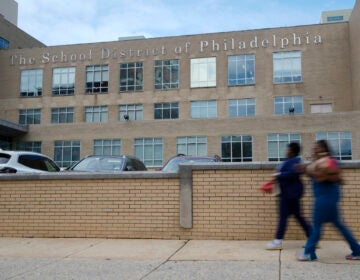Will small Philadelphia high schools survive building consolidations?
In the next three years, the Philadelphia School District plans to close up to 50 buildings. Many are worried about what the plan will mean for Philadelphia’s small high schools.
“I teach at a small school with just under 300 students, and we’ve been hearing that the District is getting away from the small schools,” said Rob Powlen, a math teacher and basketball coach at Paul Robeson High in West Philadelphia. “I was just concerned. I mean, I’ve been there for 15 years, and it’s just nice to have a small setting where you know all the kids, you know all the teachers. It’s just more of a nurturing environment, I think.”
Robeson is one of 25 high schools serving 700 students or fewer that were created under the leadership of previous district chief Paul Vallas. Tracey Hartmann of Research for Action helped lead a 2009 study which found that being small helped those schools create a safer, more personalized learning environment for students.
“Our research found … that there was definitely a benefit in terms of climate from small size,” said Hartmann. “Students in focus groups told us that they didn’t feel anonymous. There were less conflicts, and they felt a sense of family or community in their schools.”
Nationally, research on the academic impact of small high schools has been mixed. And in unveiling the school district’s new facilities master plan, Superintendent Arlene Ackerman said the expense of maintaining the schools may well outweigh their benefits.
“We’re not saying we shouldn’t have small schools,” said Ackerman, “but there is a place where small schools become fiscally not viable.”
The district has 70,000 empty seats now and wants to cut that number in half. Although the district is closely guarding details of its plans for specific schools, officials say that all options–including closures, consolidating multiple schools, or locating multiple schools in a single building–are on the table. District consultant Tracy Richter explained that one factor in making decisions will be new guidelines that recommend that high schools enroll between 1,000 and 1,200 students.
“When high schools, or any schools for that matter, begin to be too small, then you start to restrict yourself on program offerings,” said Richter. “For instance, if a high school didn’t have that type of enrollment in it, it would be very challenging to offer advanced placement courses, even some career and technical services, those kinds of things.”
Taisha Martinez, a student at the 529-student Kensington High School for the Creative and Performing Arts, disagrees. As a member of student organizing group Youth United Change, she helped fight to convert troubled Kensington High into four smaller schools. She says it made a big difference.
“Four hundred or 500 students in a school is way better than 1,000 to 1,200 because it’s a smaller learning community, everybody can get along better, everybody can communicate better, your relationship with your teacher is better,” Martinez said. “In the end, small schools are better.
The School Reform Commission will vote on a draft plan May 18, but specifics won’t be released until October.
If you’d like to make your voice heard about the facilities plan, details are available on the district’s website.
WHYY is your source for fact-based, in-depth journalism and information. As a nonprofit organization, we rely on financial support from readers like you. Please give today.




